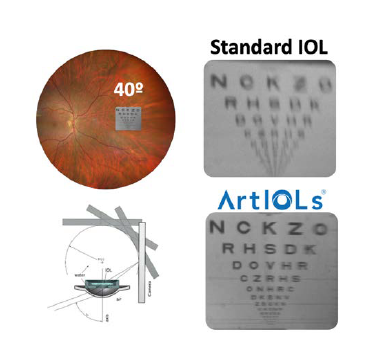Cataract and Refractive Articles
New IOL Underscores Importance of Peripheral Vision
Inverted meniscus design now in clinical trials.

Dermot McGrath
Published: Thursday, March 2, 2023
“ The inverted meniscus IOL more closely mimics the optics of the natural crystalline lens, reduces astigmatism, and improves peripheral vision, which may help to improve safety and quality of life after cataract surgery. “
A new inverted meniscus-shaped intraocular lens (ArtIOL, Voptica SL) successfully reduces oblique astigmatism and provides improved peripheral vision compared to a standard IOL, according to Pablo Artal PhD.
“Current IOLs typically degrade the optical quality at the peripheral retina, thereby compromising quality of vision,” he said. “The inverted meniscus IOL more closely mimics the optics of the natural crystalline lens, reduces astigmatism, and improves peripheral vision, which may help to improve safety and quality of life after cataract surgery.”
Dr Artal explained that interest in the eye’s optical quality has traditionally focused on the central fovea area of the retina, with little attention paid to the peripheral retina.
“The reality is peripheral vision is extremely important for driving and many activities in daily life,” he said. “Our natural eye has pretty good resolution in the centre and less so in the periphery, but this low-resolution information is still extremely useful for our day-to-day activities.”
The optics of the natural eye are compromised at the periphery, but Dr Artal noted this is rarely perceptible.
“We all have around 5.0 D to 7.0 D of astigmatism at 40 degrees, but we don’t complain about it as the photoreceptors and neural sampling limits our vision. So, our natural eye is beautifully adapted to our retinal capabilities,” he said.
Making the most of peripheral vision
Standard biconvex IOLs provide a wrong field curvature with additional defocus blur and increased peripheral astigmatism compared with the optics in a normal eye with the crystalline lens intact. This leads to compromised vision and a potential increased risk of falls, poor object recognition, and driving difficulties.
“We have to bear in mind the peripheral optics were already bad in a normal eye. Therefore, it is even worse in a pseudophakic eye,” Dr Artal said.
To address this issue, Dr Artal developed the ArtIOL—a single-piece, foldable lens with a square-edge design and UV and blue light filter delivered through a 2.2-mm incision.
“It’s a standard lens in all respects—apart from the inverted meniscus design,” he said, adding optical bench testing of the lens has shown promising results in its ability to correct the optics of the pseudophakic eye and improve peripheral vision. A recent clinical study reported patients implanted with the ArtIOL showed reduced amounts of peripheral defocus and astigmatism compared to patients implanted with standard biconvex IOLs. A better contrast sensitivity in the periphery was also reported for the patients implanted with ArtIOLs.
More than 2,000 ArtIOLs have been implanted already, Dr Artal said, with excellent results for the patients. He concluded that as the population ages and the prevalence of cataracts increases, developing better IOLs that improve overall vision, including peripheral vision, will be important for maintaining independence and quality of life.
Dr Artal presented at the 40th Congress of the ESCRS in Milan.
Pablo Artal PhD is a professor of optical physics at the University of Murcia, Spain. pablo@um.es

Latest Articles
Towards a Unified IOL Classification
The new IOL functional classification needs a strong and unified effort from surgeons, societies, and industry.
The 5 Ws of Post-Presbyopic IOL Enhancement
Fine-tuning refractive outcomes to meet patient expectations.
AI Shows Promise for Meibography Grading
Study demonstrates accuracy in detecting abnormalities and subtle changes in meibomian glands.
Are There Differences Between Male and Female Eyes?
TOGA Session panel underlined the need for more studies on gender differences.
Simulating Laser Vision Correction Outcomes
Individualised planning models could reduce ectasia risk and improve outcomes.
Need to Know: Aberrations, Aberrometry, and Aberropia
Understanding the nomenclature and techniques.
When Is It Time to Remove a Phakic IOL?
Close monitoring of endothelial cell loss in phakic IOL patients and timely explantation may avoid surgical complications.
Delivering Uncompromising Cataract Care
Expert panel considers tips and tricks for cataracts and compromised corneas.
Organising for Success
Professional and personal goals drive practice ownership and operational choices.